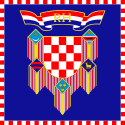List of Presidents of Croatia
This is a list of heads of state of Croatia. Historically, the first republican heads of state of Croatia (then a constituent republic of the SFR Yugoslavia) were the Presidents of the Presidium of the Croatian Parliament, an office notably distinct from the Speaker of the Parliament (Predsjednik Sabora). When the Presidium was abolished in the constitutional reforms of 1953, the position defaulted to the Presidents of the Parliament. In 1974, a new constitution brought about a collective Croatian Presidency, with the President of the Presidency as head of state of the Republic. The next constitution of 1990 abolished the Presidency and established a single office of the President, which (under a new semi-presidential system) was now much more empowered than any of the previous offices. Up until this point, the various heads of state wielded far less real executive power than the Prime Ministers.
Since 1990, the President of the Republic of Croatia (Predsjednik) is directly elected to a five-year term and is limited to a maximum of two terms. However, with the constitution of 2001, the powers of the President (much expanded in 1990) were now again severely curtailed, as Croatia shifted from a semi-presidential system, to an incomplete parliamentary system. As in most parliamentary systems, the President is now by-and-large a ceremonial office, with the Prime Minister de facto heading the executive branch.
Heads of state of the Socialist Republic of Croatia (1943–1990)
League of Communists of Yugoslavia (15)
| No. | Portrait | Name (Birth–Death) |
Term start | Term end | Party | Notes | ||
|---|---|---|---|---|---|---|---|---|
| President of the State Anti-fascist Council for the National Liberation of Croatia (ZAVNOH) 1943-1945 | ||||||||
| — | 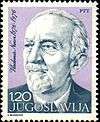 |
Vladimir Nazor (1876–1949) |
13 June 1943 | 21 August 1945 | Independent[1] | From 1943 to 1945, formal head of state as Speaker of the ZAVNOH (Croatian wartime assembly). After WWII, served as head of state in the function of President of the Presidium of the Parliament. First head of state of modern Croatia. Died in office. | ||
| Presidents of the Presidium of Parliament 1943–1953 | ||||||||
| 1 |  |
Vladimir Nazor (1876–1949) |
26 February 1946 | 19 June 1949 | Independent[2] | |||
| 2 |  |
Karlo Mrazović (1902–1987) |
15 October 1949 | 1952 | Communist Party of Yugoslavia | |||
| 3 | .jpg) |
Vicko Krstulović (1905–1988) |
February 1952 | 6 February 1953 | ||||
| Speakers of the Parliament (Sabor) 1953–1974 | ||||||||
| 4 |  |
Zlatan Sremec (1898–1971) |
6 February 1953 | December 1953 | League of Communists of Yugoslavia | Speaker of Parliament since 1946, became formal head of state (as Speaker) on 6 February 1953 with the abolition of the Presidium | ||
| 5 | .jpg) |
Vladimir Bakarić (1912–1983) |
December 1953 | December 1963 | League of Communists of Yugoslavia | Longest term to date as Croatian head of state, also served as Prime Minister of Croatia, People's Hero of Yugoslavia | ||
| 6 |  |
Ivan Krajačić (1906–1986) |
December 1963 | June 1967 | League of Communists of Yugoslavia | |||
| 7 | 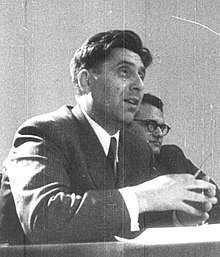 |
Jakov Blažević (1912–1996) |
June 1967 | April 1974 | League of Communists of Yugoslavia | |||
| 8 |  |
Ivo Perišin (1925–2008) |
April 1974 | 8 May 1974 | League of Communists of Yugoslavia | Ceased to be the head of state with the establishment of the Collective Presidency on 8 May 1974; continued on as Speaker until 1978. Also at one time held the positions of Prime Minister of Croatia, and Mayor of Split. | ||
| Presidents of the Presidency of the Socialist Republic of Croatia 1974–1990 | ||||||||
| 9 |  |
Jakov Blažević (1912–1996) |
8 May 1974 | May 1982 | League of Communists of Yugoslavia | |||
| 10 | 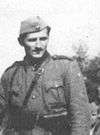 |
Marijan Cvetković (1920–1990) |
May 1982 | May 1983 | League of Communists of Yugoslavia | |||
| 11 |  |
Milutin Baltić (1920–2013) |
May 1983 | 10 May 1984 | League of Communists of Yugoslavia | |||
| 12 |  |
Jakša Petrić (1922–1993) |
10 May 1984 | 10 May 1985 | League of Communists of Yugoslavia | |||
| 13 |  |
Pero Car (1920–1985) |
10 May 1985 | 15 November 1985 | League of Communists of Yugoslavia | Died in office | ||
| 14 | 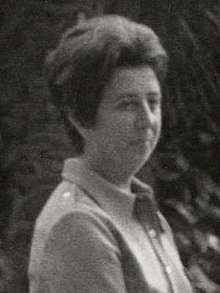 |
Ema Derossi-Bjelajac (1926– ) |
20 November 1985 | 10 May 1986 | League of Communists of Yugoslavia | First female head of state of modern Croatia | ||
| 15 | Ante Marković (1924–2011) |
10 May 1986 | May 1988 | League of Communists of Yugoslavia | Also at one time Prime Minister of Croatia and last Prime Minister of Yugoslavia. Led reforms terminated by the ensuing Yugoslav Wars. | |||
| 16 |  |
Ivo Latin (1929–2002) |
May 1988 | 30 May 1990 | League of Communists of Yugoslavia | |||
| President of the Presidency of the Republic of Croatia 30 May 1990–22 December 1990 | ||||||||
| 17 | Franjo Tuđman (1922–1999) |
30 May 1990 | 22 December 1990 | Croatian Democratic Union | Constitutional amendments in July 1990, following the first free Croatian Parliamentary elections, changed the formal title to "President of the Presidency of the Republic of Croatia" and expanded presidential powers. New constitution (third since 1945) drafted later that year. | |||
Presidents of the Republic of Croatia (1990–present)
On 30 May 1990 Franjo Tuđman was elected by Parliament as the President of the Presidency of the Socialist Republic of Croatia, then still a constituent republic of the Socialist Federal Republic of Yugoslavia, and held office together with several Vice Presidents of the Presidency of SR Croatia. The collective presidency was reduced to seven members on 25 July 1990 and the name of the constituent Yugoslav republic was changed to the Republic of Croatia by removing the word Socialist from its name and the names of its institutions. The collective presidency was completely abolished in favor of the post of President of the Republic of Croatia with the adoption of a new constitution on 22 December 1990. The Croatian Parliament then declared independence on 25 June 1991, when Tuđman formally became the first president of an independent Croatian nation under the name the Republic of Croatia. Thus, the current office is not considered a continuation of the line of heads of state who held office while Croatia was a constituent republic in Yugoslavia, called SR Croatia (until 25 July 1990) and the Republic of Croatia (25 July-22 December 1990), and whose heads of state held a sub-national office.
(*)The constitutional amendments of November 2000 abandoned a semi-presidential system for a parliamentary system (with a directly elected president) and also made the presidency a non-partisan office, meaning that even if they are elected to office as a candidate of a particular political party, he or she must resign membership in that party before taking office as president.
Croatian People's Party – Liberal Democrats (1)
Social Democratic Party of Croatia (1)
| No. | Picture | Name (Birth–Death) |
Term of office | Election | Party | ||
|---|---|---|---|---|---|---|---|
| No. | Term start | Term end | |||||
| 1 | Franjo Tuđman (1922–1999) |
— | 30 May 1990 | 12 August 1992 | — | Croatian Democratic Union | |
| 1 | 12 August 1992 | 12 August 1997 | 1992 (56.73%) | ||||
| 2 | 12 August 1997 | 10 December 1999 | 1997 (61.41%) | ||||
| Parliament elected him the President of the Presidency of SR Croatia in May 1990, but with the adoption of a new constitution on 22 December 1990, the title of the office was changed to President of the Republic of Croatia and the Presidium of Croatia (Presidency) was completely abolished. The referendum on independence was held in May 1991, with 93% of voters supporting independence. It was followed by a formal declaration of independence on 25 June 1991, the same date as neighboring Slovenia. Tuđman survived an assassination attempt by the Yugoslav Air Force on 7 October 1991, which targeted not only him, but also the then-President of the Presidency of Yugoslavia Stjepan Mesić and then-Prime Minister of Yugoslavia Ante Marković. Croatia and Slovenia gained recognition by the European Union on 15 January 1992 and joined the United Nations in May 1992. Tuđman won re-election to a de facto second and third term in 1992 and 1997, winning election outright both times without the need for a run-off. He is the only president to have been elected in the first round of elections. Croatian Serbs begin to rise up, resulting in the Log Revolution in 1990. Most of Tuđman's first and second terms (1990-1997) was marked by the Croatian War of Independence, which took place from 1991 to 1995. Over a third of Croatia was occupied by Serb paramilitary forces and the Yugoslav National Army (JNA). The city of Vukovar, after initially withstanding an 87-day long siege fell to the JNA on 18 November 1991, with the number of casualties in battle ranging from 2500 to 3600. Key military operations authorized by Tuđman in the war are Operation Maslenica, Operation Medak Pocket, Operation Winter '94, Operation Flash and Operation Storm. A war also broke out between the Croatian Republic of Herzeg-Bosnia, an unrecognized entity and the Republic of Bosnia and Herzegovina. The conflict was resolved by the Washington Agreement in 1994, of which Tuđman is a co-signatory along with Haris Silajdžić and Krešimir Zubak. The Erdut Agreement, signed in November 1995 paved the way for the establishment of a UN mission in eastern Croatia (UNTAES) and the peaceful re-integration in 1998 of the areas formerly occupied by the self-declared SAO Eastern Slavonia, Baranja and Western Syrmia. Tuđman is, along with Alija Izetbegović and Slobodan Milošević, a co-signatory of the Dayton Agreement which ended the Bosnian War. The kuna replaced the Croatian dinar as the official currency in 1994. The 1990s were marked by a severely flawed transition from a planned economy to a market economy (commonly referred to in Croatia as privatization done the Croatian way), the most evident features of which were politically biased appointments of officials close to the ruling HDZ to positions within many major Croatian companies and widespread corruption. This resulted among other things in a drastic rise in unemployment, an increase of poverty levels, the inability of the Croatian economy to be competitive on the global market and create new markets for domestic products, a drastic fall in industrial production and the loss of monetary sovereignty by the Croatian National Bank in favor of the European Central Bank, causing Croatia to have to indebt itself on the foreign market on unfavourable terms, with the resulting external debt being ever-growing. Tuđman often displayed authoritarian tendencies and was able to expand his powers beyond constitutional limits due to a large HDZ parliamentary majority. Therefore, an extremely powerful semi-presidential system (or rather superpresidential system) existed until Tuđman's death and resulted most notably in events such as the Zagreb crisis. He died in office in December 1999. | |||||||
| — |  |
Vlatko Pavletić (1930–2007) |
— | 10 December 1999 | 2 February 2000 | Acting President | Croatian Democratic Union |
| Tuđman was incapacitated since 26 November 1999 and died on 10 December 1999. Pavletić became acting president as Speaker of the Croatian Parliament. He was succeeded by Zlatko Tomčić when the 4th Assembly of Parliament was replaced by the 5th Assembly after the 2000 election. | |||||||
| — | 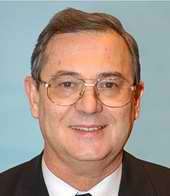 |
Zlatko Tomčić (1945–) |
— | 2 February 2000 | 18 February 2000 | Acting President | Croatian Peasant Party |
| Became acting president as Speaker of Parliament when the 4th Assembly of Parliament (1995-2000) was replaced by the 5th Assembly (2000-2003). Served until Stjepan Mesić was sworn in as the new President on 18 February 2000. | |||||||
| 2 |  |
Stjepan Mesić (1934–) |
3 | 18 February 2000 | 18 February 2005 | 2000 (56.01%) | Croatian People's Party – Liberal Democrats* (formally independent) |
| 4 | 19 February 2005 | 18 February 2010 | 2005 (65.93%) | ||||
| Before his tenure as president, he served as the President of the Executive Council of SR Croatia (1990), the Croatian Member of the Presidency of Yugoslavia (1990-1991), the President of the Presidency of Yugoslavia (1991), the Secretary General of the Non-Aligned Movement (1991) and the Speaker of the Croatian Parliament (1992-1994). He defeated Dražen Budiša in the 2000 presidential elections. He was the first president with reduced powers, as the semi-presidential system was replaced by an incomplete parliamentary system in November 2000. During his first term Croatia joined NATO's Partnership for Peace and became a member of the World Trade Organization in 2000. Furthermore, Croatia applied for membership in the European Union in 2003. Mesić was re-elected in 2005, defeating Jadranka Kosor in a landslide. During his second term Croatia became a full member of NATO in 2009. Slovenia blocked Croatia's EU membership negotiations from 2008 to 2009. Longtime Prime Minister Ivo Sanader submitted his surprise resignation in July 2009 and was succeeded by Jadranka Kosor, the first woman to hold the office. He often worked against Croatia interest and denounced it by sharing sensitive documents from the president Tuđman office. | |||||||
| 3 | 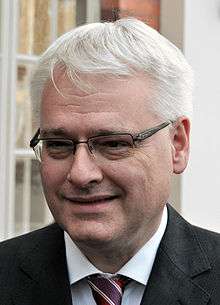 |
Ivo Josipović (1957–) |
5 | 19 February 2010 | 18 February 2015 | 2009-10 (60.26%) | Social Democratic Party* (formally independent) |
| Before becoming president he served as a Member of Parliament for the 1st electoral district from 2003 until 2010. He defeated Milan Bandić by a wide margin in the 2010 election. During his term, Slovenia unblocked Croatia's EU accession negotiations. This was followed by the conclusion of accession negotiations with the EU in June 2011. He co-signed the EU accession treaty in December 2011. As a result, the successful EU membership referendum took place in 2012. Croatia officially became the 28th member country of the EU on 1 July 2013. In 2013 Josipović and his Slovenian counterpart Borut Pahor established a regional forum and dialogue initiative named the Brdo-Brijuni Process, bringing together the leaders of seven former Yugoslav countries, as well as the leaders of Albania and Austria. The referendum on the constitutional definition of marriage was held in December 2013. He pursued the normalization of relations with Serbia, apologized for the Paulin Dvor massacre in 2010 (previously Serbian President Boris Tadić had done so for the Ovčara massacre) and gave a speech in the National Assembly of Serbia in 2013. The Life Partnership Act is introduced in 2014, giving same-sex couples almost all the rights enjoyed by heterosexual married couples (though most notably still limiting adoption rights). He was narrowly defeated by Kolinda Grabar-Kitarović in his re-election bid in 2015. | |||||||
| 4 | 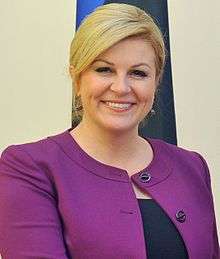 |
Kolinda Grabar-Kitarović (1968–) |
6 | 19 February 2015 | Incumbent | 2014-15 (50.74%) | Croatian Democratic Union* (formally independent) |
| She is a former Minister of Foreign Affairs, Ambassador to the United States and Assistant Secretary General for Public Diplomacy at NATO. She defeated Ivo Josipović in the second round of 2015 election. She is the first female president since independence and also the youngest, aged 46. A migrant crisis began in September 2015 and over 650.000 refugees passed through Croatia by May 2016. She is pursuing closer relations with Eastern European and Visegrád Group countries as part of the Baltic, Adriatic and Black Sea Initiative (BABS Initiative or Three Seas Initiative) and advocates the normalization of relations with Serbia. Furthermore, she promotes greater involvement of the Croatian diaspora in home affairs and vice versa. She has outlined demographic regeneration, the return of citizens working abroad, economic growth, restoration of national unity (based on that of the 1990s War of Independence) and ideological reconciliation as key elements of her policy agenda. The first half of her term was marked by relative instability of government, resulting in three prime ministers holding office in less than one year (Zoran Milanović, Tihomir Orešković and Andrej Plenković) and two parliamentary elections taking place in as much time (in 2015 and 2016). The 2015 election had resulted in a severely fragmented and ideologically polarized hung parliament and Grabar-Kitarović's normally mostly ceremonial role as president drastically gained in importance, as the 76-day long process (the longest government formation in Croatian history) of negotiating an ultimately very small parliamentary majority, which in turn led to the appointment of the non-partisan technocrat Orešković to the role of prime minister, had numerous times seemed as if it would result in an early election without a new government taking office. She had ultimately come extremely close to dissolving Parliament and appointing a non-partisan interim government until new elections could take place, which would have been a first in Croatia. This was however narrowly averted on 23 December 2015 with a pact between HDZ and MOST in which they agreed to support Orešković as a consensus candidate for prime minister. Furthermore, Grabar-Kitarović's term is marked by a rise in right-wing nationalism and ideological polarization (commonly referred to in Croatia by the phrase the Ustaše vs the Partisans) and mixed relations with Serbia, most prominently exhibited in periodic verbal conflicts with Prime Minister (and later President) Aleksandar Vučić and other Serbian government officials. These periods of strained relations have occasionally been replaced with periods of expressed hope for cooperation on solving common issues and warmer mutual relations. | |||||||
Statistics
A - Acting President
(*) From the abolishment of the collective Presidency of the Republic of Croatia on 22 December 1990
| # | President | Age at ascension (first term) |
Time in office (total) |
Age at retirement (last term) |
|---|---|---|---|---|
| 1 | Franjo Tuđman | 68 years, 222 days* | 8 years, 353 days | 77 years, 210 days |
| A | Vlatko Pavletić | 69 years, 8 days | 0 years, 54 days | 69 years, 62 days |
| A | Zlatko Tomčić | 54 years, 118 days | 0 years, 16 days | 54 years, 134 days |
| 2 | Stjepan Mesić | 65 years, 56 days | 10 years, 0 days | 75 years, 56 days |
| 3 | Ivo Josipović | 52 years, 175 days | 5 years, 0 days | 57 years, 175 days |
| 4 | Kolinda Grabar-Kitarović | 46 years, 295 days | 3 years, 243 days (Ongoing) | Incumbent |
Spouses of Croatian Presidents
See also: Spouses of Croatian Presidents and Prime Ministers
The First Lady or First Gentleman of Croatia is the informal title given to the wife or husband of the President of Croatia. It is used almost exclusively outside the country itself or by foreign media sources, while within Croatia itself the spouse of the President is usually referred to as either the wife of the President of the Republic or the husband of the President of the Republic, rather than being referenced as a First Spouse. The title carries no official or formal duties and is purely honorary.
| Name | Relation to President | Assumed position | Left position | Lifespan |
|---|---|---|---|---|
| Ankica Tuđman (née Žumbar) | Wife of Franjo Tuđman | 30 May 1990 | 10 December 1999 | 1926– |
| Neda Pavletić (née Majnarić) | Wife of Vlatko Pavletić | 10 December 1999 | 2 February 2000 | 1930–2017 |
| Slavica Tomčić | Wife of Zlatko Tomčić | 2 February 2000 | 18 February 2000 | 1953– |
| Milka Mesić (née Dudunić) | Wife of Stjepan Mesić | 18 February 2000 | 18 February 2010 | 1939– |
| Tatjana Josipović (née Klepac) | Wife of Ivo Josipović | 19 February 2010 | 18 February 2015 | 1962– |
| Jakov Kitarović | Husband of Kolinda Grabar-Kitarović | 19 February 2015 | Incumbent | 1968– |
Facts and records of Presidents of Croatia
Age
- Oldest first-term president: Franjo Tuđman (68 years, 222 days) - Note: technically first term but regarded as interim term (1990-1992) until direct elections could take place in 1992.
- Oldest president upon second inauguration: Franjo Tuđman (70 years, 91 days) - Note: technically second term (1992-1997) but regarded as first term under constitutional provision and first following introduction of direct elections.
- Oldest President at beginning of final term: Franjo Tuđman (75 years, 91 days)- Note: technically third term (1997-1999) but regarded as second under constitutional provision and second following introduction of direct elections
- Oldest president upon end of final term: Franjo Tuđman (77 years, 210 days)
- Oldest head of state (overall) upon entering office: Vlatko Pavletić (as acting President) (69 years, 8 days)
- Youngest president upon inauguration: Kolinda Grabar-Kitarović (46 years, 295 days)
- Youngest president upon second inauguration: Stjepan Mesić (70 years, 56 days)
- Youngest president upon end of term: Ivo Josipović (57 years, 175 days)
- Youngest president upon end of second term: Stjepan Mesić (75 years, 56 days)
- Youngest head of state (overall) upon end of term: Zlatko Tomčić (as acting President) (54 years, 134 days)
Terms and elections
- Three terms: Franjo Tuđman (1990-1992, 1992-1997, 1997-1999)
- Two terms: Stjepan Mesić (2000-2005, 2005-2010)
- One term: Ivo Josipović (2010-2015), Kolinda Grabar-Kitarović (in office since 2015)
- Longest serving president: Stjepan Mesić (10 years, 0 days/ 3653 days)
- Shortest serving president with complete term: Ivo Josipović (5 years, 0 days/ 1826 days)
- Shortest serving head of state: Zlatko Tomčić (as acting president) (16 days)
- Highest vote percentage in an election (overall): Stjepan Mesić (65,93%) - second round in 2000
- Highest vote percentage in an election (first round): Franjo Tuđman (61,4%) - in 1997
- Lowest vote percentage in an election (second round): Kolinda Grabar-Kitarović (50,74%) - in 2015
- Lowest vote percentage in an election (first round): Ivo Josipović (32,42%) - in 2009
- Highest number of votes in an election (overall): 1.519.000 (Franjo Tuđman in 1992)
- Highest number of votes in second round: 1.454.451 (Stjepan Mesić in 2005)
- Lowest number of votes in an election (overall): 640.594 (Ivo Josipović in first round in 2009)
- Lowest number of votes in second round: 1.114.945 (Kolinda Grabar-Kitarović in 2015)
- Largest margin of victory in a direct election (%): 40,4% (Franjo Tuđman (61,4%) and Zdravko Tomac (21%) in 1997)
- Largest margin of victory in a direct election (votes): 933.565 votes (Franjo Tuđman and Dražen Budiša in 1992)
- Smallest margin of victory in a direct election (%): 1,48% (Kolinda Grabar Kitarović (50,74%) and Ivo Josipović (49,26%) in 2015 (second round)
- Smallest margin of victory in a direct election (votes): 32.509 (Kolinda Grabar-Kitarović and Ivo Josipović in 2015 (second round))
- Only indirectly elected president: Franjo Tuđman (by 281 of 338 votes of Members of Parlimanet in 1990)
Other facts and figures
- First female president: Kolinda Grabar-Kitarović
- First former Prime Minister to become President: Stjepan Mesić
- First former Speaker of Parliament to be elected President: Stjepan Mesić
- Only former President of the Presidency of Yugoslavia to become President: Stjepan Mesić
- Only President to have been head of state of more than one independent country: Stjepan Mesić (as President of the Presidency of Yugoslavia (1990-1991) and President of Croatia (2000-2010))
- Only President to have held all three highest offices of government (President of the Republic, Speaker of Parliament and Prime Minister): Stjepan Mesić
- Only President who has at some point been Secretary General of the Non-Aligned Movement: Stjepan Mesić (as President of the Presidency of Yugoslavia)
- President with most Prime Ministers serving during term: Franjo Tuđman (6 Prime Ministers - Stjepan Mesić, Josip Manolić, Franjo Gregurić, Hrvoje Šarinić, Nikica Valentić, Zlatko Mateša)
- Only president to die in office: Franjo Tuđman
See also
- List of Presidents of Croatia by longevity
- List of spouses of Croatian Presidents and Prime Ministers
- Speaker of the Croatian Parliament
- Prime Minister of Croatia
- List of Croatian Governments
- Speaker of the Chamber of Counties of Croatia
- Secretary of the League of Communists of Croatia
- List of heads of state of Yugoslavia
- Prime Minister of Yugoslavia
- List of female county prefects in Croatia
References
- ↑ Member of the Unitary National Liberation Front, i.e. the National Front
- ↑ Member of the Unitary National Liberation Front, i.e. the National Front

